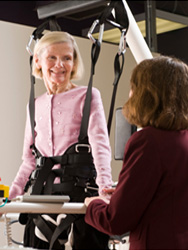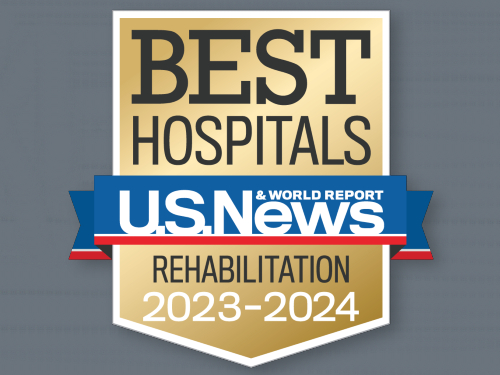
Following acute care for stroke, a Houston woman benefits from innovative neurorehabilitative technology and integrated care at Mischer Neuroscience Institute and TIRR Memorial Hermann.
Dorothy Malone was devastated when she suffered a stroke in April of 2008. “Before my stroke, I walked on the treadmill every morning for an hour. I worked out with a trainer and lifted weights twice a week. I had a healthy diet and didn’t smoke or drink. I was a very independent 78 year old.”
Previously diagnosed with atrial fibrillation, Malone had tried a variety of antiarrhythmic medications, including anticoagulants. When she began having dizzy spells, she and her children knew something was wrong.
“I was sitting on the sofa eating breakfast and watching TV,” recalls Malone, who lives alone. “When I tried to stand up, my knees buckled. Then the phone started ringing. Both of my children call me every day, and I knew it was one of them.”
When her mother didn’t answer the phone after three calls, Molly Malone drove to the apartment. “I knew something was wrong,” she says. “On the way, I called a very close friend, Sue Porretto, and asked her to meet me there. Mom had the door dead-bolted, so I couldn’t get in. She heard me pounding on the door and when I heard her voice – and knew she was alive – I called 911.”
The Stroke Center at Mischer Neuroscience Institute
After the ambulance transport and a long wait in the emergency room of another Houston hospital, Porretto called Frank Yatsu, MD, a neurologist affiliated with Memorial Hermann-Texas Medical Center and professor of neurology at The University of Texas Medical School at Houston. Dr. Yatsu facilitated Malone’s transfer to the Stroke Center at Mischer Neuroscience Institute, where she was admitted on April 8, 2008, under the care of neurologist Nicole Gonzales, MD, an assistant professor of neurology at the UT Medical School. She was diagnosed with a right middle cerebral artery stroke secondary to atrial fibrillation.
When Malone was stabilized, she was transferred to the hospital’s 23-bed inpatient neurorehabilitation unit for comprehensive care and an aggressive program of physical therapy, occupational therapy and speech/language pathology. Mischer Neurorehabilitation's multidisciplinary team – a physician, nurse practitioner, neuropsychologist, rehabilitation nurse, case manager and social worker for each patient – is led by medical director Elizabeth Noser, MD, medical director of neurorehabilitation for the Memorial Hermann Healthcare System. She and Nneka Ifejika, MD, directed Malone’s neurorehabilitative care.
“Mrs. Malone came to our service just four days after her stroke,” says Dr. Ifejika, who is medical director of neurorehabilitation at Memorial Hermann-TMC and assistant professor and director of neurorehabilitation at the UT Medical School, “We believe the sooner you get to rehab following a stroke the better. Once a patient arrives on our unit, we’re very aggressive with therapy.”
Therapy for Stroke
During her recovery, Malone benefited from Mischer Neurorehabilitation's innovative technology, including the Bioness Foot Drop System. “The Bioness uses mild stimulation to lift the patient’s foot to aid in walking,” Dr. Ifejika says. “With most patients, return of use occurs in the leg gradually from the hip on down. The foot tends to drop, which puts people at risk for falls. The system helps patients regain the use of the involved foot faster.”
The Bioness Foot Drop System has three components that communicate with each other wirelessly. A leg cuff fits just below the knee to place stimulation where it helps the patient most. The gait sensor attaches to the patient’s shoe and “tells” the leg cuff whether the heel is on the ground or in the air. A handheld remote control lets the patient adjust the stimulation levels and on-off controls.
Malone’s rehabilitation team also used the Bioness Hand Rehabilitation System to speed the return of wrist extension. She progressed well, was discharged to her home in mid-May and began outpatient rehabilitation at TIRR Memorial Hermann.
Innovative Stroke Rehab Technology
At TIRR Memorial Hermann, Malone was one of the first patients to use the outpatient rehabilitation facility’s Lokomat®, the world’s first driven-gait orthosis. Designed to benefit patients with neurological movement disorders, the system consists of the robotic gait orthosis itself and the Levi body-weight support system used in combination with a treadmill. The patient’s legs are guided on the treadmill according to a preprogrammed physiological gait pattern, which can be adjusted to accommodate individual needs and rehabilitation goals. Advantages of Lokomat-based therapy include faster progress through longer and more intensive training sessions compared to manual treadmill training, ease of monitoring and assessment of patient walking activity and improved motivation through visualized performance feedback.
In July, Malone suffered a setback when she fell at home and injured her left hand. “We got a call from Mrs. Malone’s daughter saying she was back in the hospital being treated for a hematoma on her involved side,” Dr. Ifejika says. “Drainage and a skin graft were required. She became deconditioned because of the surgery, and we began the entire rehabilitation process over again.”
Following her discharge from Memorial Hermann-TMC in August, Malone completed four months of home therapy. She started back on the Lokomat at Kirby Glen in January 2009.
“I am determined to regain my independence,” she says. “My left hand is starting to come back. I’m very optimistic that I’m going to regain the use of my left arm and leg. The therapists at Kirby Glen and my doctors – Dr. Elizabeth Noser, Dr. Nneka Ifejika and Dr. Nicole Gonzales – are extraordinary. They are truly healers of the body and the spirit."
Positive Experience in the Stroke Rehab Program
“Doctors’ positive attitudes and enthusiasm are powerfully influencing to a patient,” she adds. “I was blessed to have doctors whose training and experience were exemplary, and who also had endless compassion, sensitivity and thoughtfulness. They let me know that no request or question was too big or too small. I could feel them with me every step of my recovery journey, and they’re still with me today.”
“Because of the length of stay in neurorehabilitation, we develop very close relationships with our patients and their families,” Dr. Ifejika says. “They’ve gone through a devastating event, and we all work together as a team to help them make the transition back to the community. Patients and family members are an integral part of that team.”
Molly Malone, who stayed at the hospital during her mother’s inpatient rehabilitation, considers it a positive experience. “We marveled at all the positive things we saw happening around us in the neurorehabilitation unit. There were many large and small kindnesses that really make you want to give back to that hospital. They focused on the entire person – physically, mentally and spiritually – which is how the hospital experience should be for everyone. We would have been happier not to be there, but we consider it a fantastic experience.”
Dorothy Malone lives at home and continues to work toward regaining her independence. A caregiver helps with her daytime needs.

Nationally Ranked Rehabilitation
For the 35th consecutive year, TIRR Memorial Hermann is recognized as the best rehabilitation hospital in Texas and No. 2 in the nation according to U.S. News and World Report's "Best Rehabilitation Hospitals" in America.
Learn MoreContact Us
If you have questions or are looking for more information, please complete the form below and we will contact you.